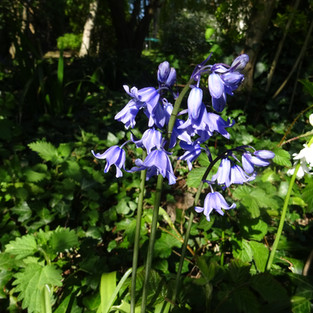St George's Day special: English native plants in my garden
- susankavanagh
- Apr 23, 2021
- 3 min read
I'm writing this on Saint George's Day so it seemed appropriate to wander around my garden and find out just how many of my plants are actually native to England.
Then answer turns out to be: very few. I'm not surprised, I've known for a long time that much of the diverse plant life of the English garden actually originated across the world. There are some surprising inclusions, after all what could be more "English" than our national flower the rose? Well it's true that dog roses are native - and are the basis of the Tudor white rose and the Lancastrian red rose - but the majority of roses we grow today originated in Asia.
We have a native crab apple (malus sylvestris) but its more edible cousin the eating apple is also of Asian origin. Most people are aware that potatoes and tomatoes originated in the Americas as do sweetcorn, peppers, pumpkin and green beans. Dates, artichokes and watermelon originated in Africa while the Middle East has given us cherries, olives, plums, lettuce, peas and spinach among others. We can thank India for mangos, lemons and cucumbers and China for apricots and peaches
Surely those pesky weeds must be English? Well yes, a lot of them are - stinging nettles, dandelions, creeping buttercups, herb robert and many more - but even some of those are imported. Ground elder, the bane of many a garden, originally grew around the Mediterranean and is thought to have been brought to us by the Romans who used its leaves in a similar way to spinach.
Most introductions have been beneficial, enchancing our diets, gardens and countryside. But a few have been problematic such as Japanese Knotweed and Water Primrose, both of which were originally introduced as ornamental plants but which have proven to be extremely invasive.
So did I find ANY native plants? Yes, a few which are either true natives or adaptations of those. In terms of trees, my rowan, holly, silver birch and elder are all natives and my golden willow is a form of Salix Alba which is also a native tree. In the "wild" section of my garden I have nettles, herb robert, dandelions, creeping buttercups, brambles and native bluebells, and my pond also scores well although that's because I populated it with a collection from Waterside Nursery (https://www.watersidenursery.co.uk/pond-planting-scheme-size-1-startup-collection-for-wildlife, British native option). Elsewhere I have calluna heathers, chives, dogwood (only the original red-stemmed species is native), hemp agrimony and ivy. Several of my ferns - the dryopteris and polystichum varieties - are native. Written down like this it sounds like a lot, but in practice these plants only take up about 5% of my garden over all. None of them are endemic to England, i.e. they're all native to other countries as well, which is beneficial because it means that even if every specimen in England were to die due to some disease there would still be plenty of these plants left elsewhere in the world.
Well, perhaps all this is as it should b. After all, St George himself was of Greek and Palestinian origin, fought in the Roman army and in addition to England he's the patron saint of Ehtiopia, Georgia, Catalonia, Aragon, Moscow and numerous organisations worldwide. In short, he's about as English as the typical English garden!
Photos left to right and top to bottom: eldlerflowers, nettles, golden willow, creeping buttercups, silver birch, pond, bluebells, crab apple, herb robert, hemp agrimony, ferns, heather

























Comments